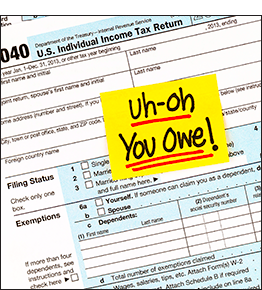Working from a home office has become a reality for many of us this year. But what, exactly, are the rules to be able to deduct your home office expenses on your tax return? Read about some ideas to help you qualify for the deduction.
Also in this month’s edition is an article suggesting ways to use depreciation to control a loan forgiveness tax surprise and some ideas for small businesses to build strong banking relationships during these uncertain times.
Please call if you would like to discuss how this information could impact your situation. If you know someone who can benefit from this newsletter, feel free to send it to them.
Turn Your Home Office Into a Tax Deduction

If you are working from home for the first time in 2020, you may be wondering if your home office is tax deductible. The bad news? If you’re working from home for an employer, you normally can’t deduct your home office expenses.
Here’s a quick look at the basic requirements to be able to deduct your home office expenses, along with some suggestions for how to qualify for the deduction if you’re currently working for your company as an employee.
The basics
There are two requirements for having a tax-deductible home office:
- Your home office is only used for business purposes. Your home office must be used exclusively for operating your business. It can’t double as the family media center or living room. To meet this requirement, set up your office in a separate area of your house. Then if you get audited by the IRS, there is no doubt that your office is used exclusively for business purposes.
- Your home office is your primary place of business. You need to demonstrate that your home office is the primary place you conduct your business. The IRS has clarified that you can meet clients and conduct meetings at separate office locations, but your home office must be the only location where your administrative work is completed. So if you meet with clients or work on any part of your business away from your home office, keep a journal of each specific activity undertaken and describe how it doesn’t violate the primary place-of-business rule.
Looking at these two criteria, everyone that is now required to work from home probably meets both qualifications. If you’re a W-2 employee, however, you can’t deduct your home office expenses on your tax return.
Solving the problem
Here are three options for solving your problem of being a W-2 employee and qualifying to deduct your home office expenses on your tax return.
- Become an independent contractor. The easiest way to deduct your home office expenses is by switching from being an employee to an independent contractor. With a number of firms cutting pay and hours due to the pandemic, it may be worth exploring. There’s a big warning label if you go this route, however. You will need to account for lost benefits such as health insurance, and the additional cost of self-employment taxes. If you can meet the IRS requirements for becoming an independent contractor, it may be worth doing the math and considering all the deductions your home office may make available to you.
- Start a side business. If becoming an independent contractor for your current employer isn’t an option, consider starting a side business. You can deduct all business-related expenses on your tax return, including your home office expenses. If you go this route, ensure your home office is in a different location in your home than your other work space.
- Consider your entire household. Even if you don’t qualify for the home office deduction, maybe someone else living in your home does qualify. So look into your options to see if a family member can take advantage of the home office deduction.
What if none of these options for deducting home office expenses are feasible for you? While you won’t be able to deduct your home office expenses on your tax return, you may still be able to end up financially ahead with the help of your employer.
Get reimbursed by your company
There’s no question you are picking up some of the expense of your home office with added electrical, heating, telephone, internet and other expenses. One way companies are solving this is by allowing employees to submit valid expense reports to cover some of these extra costs. They do this by setting up an accountable plan. With financial pressures on businesses, this might be a tough subject to broach, but if the system is already in place you may be able to find a way to get some of your home office expense reimbursed.
So if you’re stuck working as a W-2 employee, look into whether your employer offers reimbursement for home office expenses.
Figuring out how to properly deduct your home office or get reimbursed by your employer can be a lot more completed than it appears. If you need help, please call.
Common IRS Surprises

No one likes surprises from the IRS, but they do occasionally happen. Here are some examples of unpleasant tax situations you could find yourself in and what to do about them.
- An expected refund turns into a tax payment. Nothing may be more deflating than expecting to get a nice tax refund and instead being met with the reality that you actually owe the IRS more money.
- What you can do: Run an estimated tax return and see if you may be in for a surprise. If so, adjust how much federal income tax is withheld from your paycheck for the balance of the year. Consult with your company’s human resources department to figure out how to make the necessary adjustments for the future. If you’re self-employed, examine if you need to increase your estimated tax payments due in January, April, June and September.
- Getting a letter from the IRS. Official tax forms such as W-2s and 1099s are mailed to both you and the IRS. If the figures on your income tax return do not match those in the hands of the IRS, you will get a letter from the IRS saying that you’re being audited. These audits are now done by mail and are commonly known as correspondence audits. The IRS assumes their figures are correct and will demand payment for the taxes you owe on the amount of income you omitted on your tax return.
- What you can do: Assuming you already know you received all your 1099s and W-2s and confirmed their accuracy, verify the information in the IRS letter with your records. Believe it or not, the IRS sometimes makes mistakes! It is always best to ask for help in how to correspond and make your payments in a timely fashion if they are justified.
- Getting a tax bill for an emergency retirement distribution. Due to the pandemic, you can withdraw money from retirement accounts in 2020 without getting a 10% early withdrawal penalty, but you’ll still have to pay income taxes on the amount withdrawn. If you don’t plan for this extra tax you will be surprised with an additional tax bill. And you may still get an underpayment penalty bill from the IRS because you did not withhold enough during the year. You may also still receive an early withdrawal penalty in error because the IRS is still scrambling to update their systems with all of this year’s tax relief changes.
- What you can do: Set aside a percentage of your distribution for taxes. Your account administrator may withhold funds automatically for you when you request the withdrawal, so check your statements. Your review should be for both federal and any state tax obligations. If the withholding is not sufficient, consider sending in an estimated tax payment. And if you are charged a withdrawal penalty, ask for help to correspond with the IRS to get this charge reversed.
No one likes surprises when filing their taxes. With a little planning now, you can reduce the chance of having a surprise hit your tax return later.
A Happy Banker Makes for a Happy Business

With the onset of COVID-19, small business banks are more nervous about potential loan losses than ever. Here are several tips for your business to maintain a great working relationship with your lender. These same tips can also be used if you want to plant seeds with your banker for potential future loans.
- Produce timely financial statements. Your lender may require you to produce financial statements over the duration of your loans to ensure that you have enough cash to make consistent, on-time payments. Strive to produce up-to-date financial statements and send them to your bank before they ask for them. Not only will timely financial statements make your lenders happy, the pro-active nature of your financials will show a level of transparency to them. Be prepared to include a note explaining major changes and schedule regular phone calls to go over the business.
- Implement solid internal controls. How does a lender have faith that the dollar amounts on your financial statements are accurate? By properly implementing internal controls. You’ll have a happy banker if your company can provide evidence that your internal controls are operating properly.
- Communicate. If your business encounters turbulent financial waters, the best thing to do is immediately let your lender know about it. Better yet, by keeping in constant communication, your lender will most likely be able to spot if your business starts experiencing a downturn and will try devising a plan before you begin missing payment deadlines.
Remember your banker probably has their hands full right now. These tips allow them to spend more time on their problem loans, and one of them will not be yours.
Using Depreciation to Control a Loan Forgiveness Tax Surprise

Bonus depreciation and Section 179 expense can be a valuable tool to help you manage your business’ profit margin this year. Here are some thoughts to consider.
The problem
Many businesses struggling during the pandemic took out Small Business Association Payroll Protection Program loans (SBA PPP loans). The SBA’s willingness to forgive these loans is now creating a potential tax obligation. This is because the expenses used to offset this loan can no longer be deducted from the business.
So the loan forgiveness could create an unexpected taxable event.
A possible solution
Instead of paying some of the loan back to cover the tax created by the loan forgiveness, consider investing some of the funds in necessary capital purchases. You could then use special depreciation rules to manage your tax obligation. This can be done by using:
- Bonus depreciation. For assets that you purchase during the current fiscal year, you can deduct 100% of an asset’s cost using bonus depreciation. You can use this option to expense 100% of an asset’s cost using bonus depreciation this year.
- Note: This bonus depreciation is 100% in 2020 and 2021. After that the bonus depreciation amount phases out through 2025.
- Section 179 depreciation. Section 179 depreciation works similarly to using bonus depreciation, as you can deduct 100% of an asset’s cost that you purchase and place in service during the current year. You can deduct up to $1.04 million of qualified Section 179 purchases in 2020.
The downside
Whenever you use these special tax rules, you will lose the ability to take this depreciation for these capital purchases in future years, so some tax planning is required. But at least you will be able to use some of the forgiven loan proceeds to help your business, versus paying it back in the way of additional tax.
Even worse, recent IRS notices suggest the PPP loan forgiveness needs to be reflected in this year’s tax return, so you have little time if you wish to take advantage of bonus depreciation and Section 179 this tax year. To consider this option, you will need to select qualified assets and ensure they are placed in service before the end of your tax year. But if used correctly, depreciation can be used to offset business income and lower your taxes. Please call if you want to discuss your situation.
As always, should you have any questions or concerns regarding your tax situation please feel free to call.
